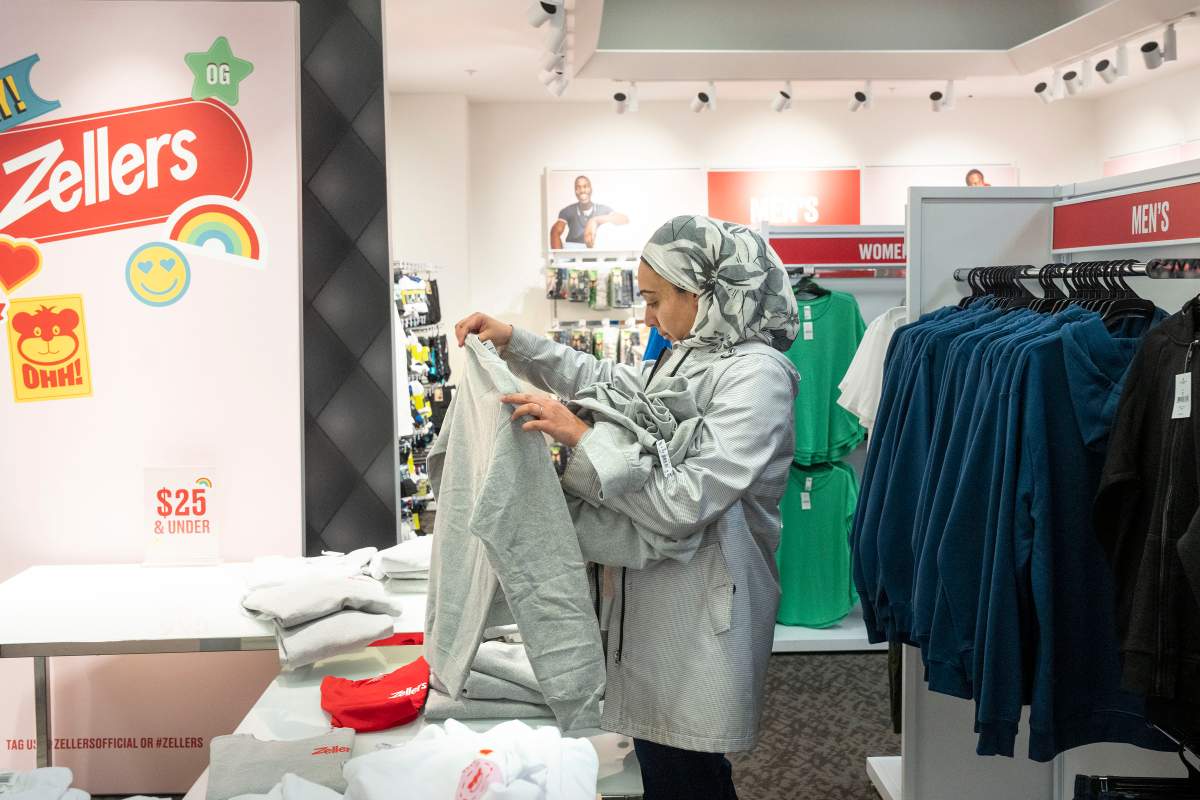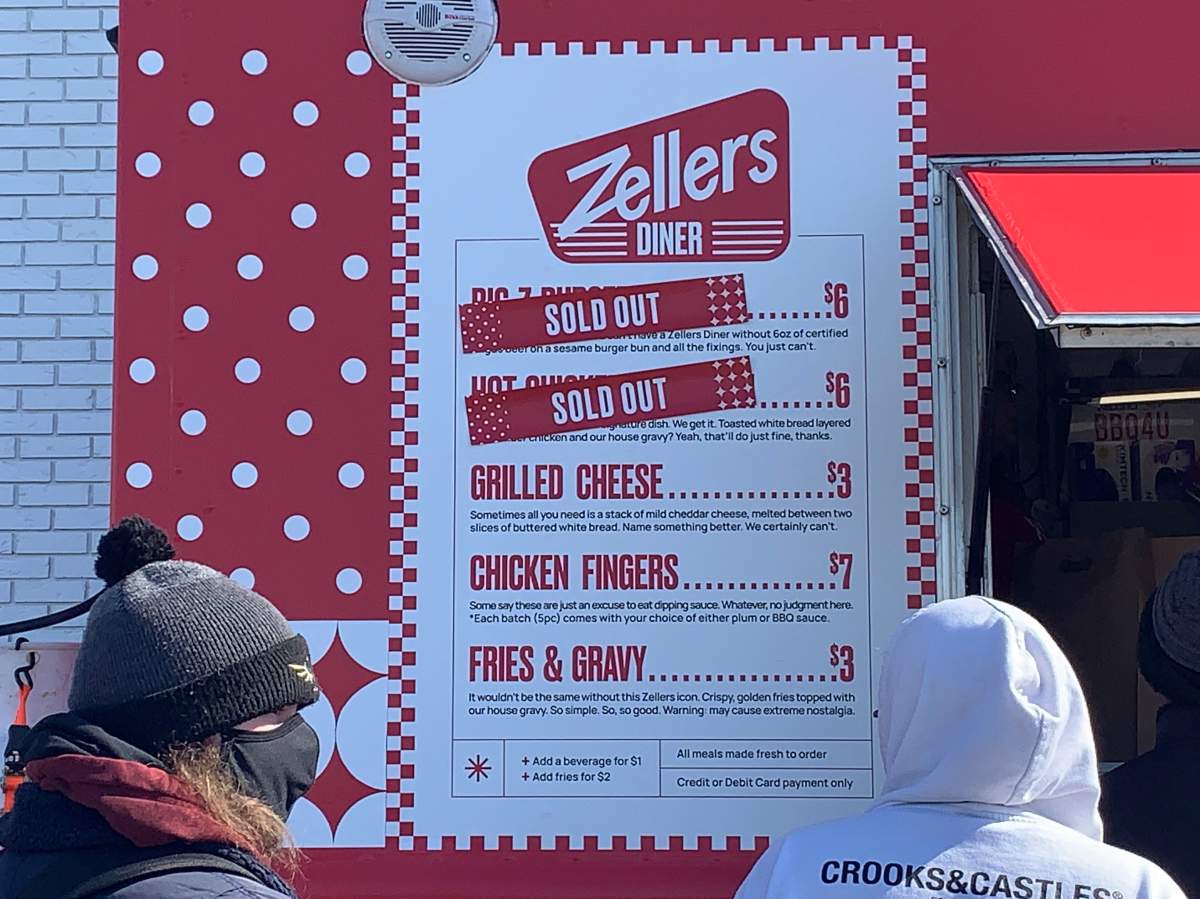The day nostalgic Canadian shoppers have been waiting for has arrived: the Zellers department store is back — kind of.

Hudson’s Bay Co. locations in Ontario and Alberta officially launched their Zellers pop-up experiences on Thursday, some complete with visits from a food truck decked out with classic recipes from the family-favourite Zellers restaurant.
The brand also launched its e-commerce platform Thursday.

Zellers-branded hoodies were on sale alongside other clothing items and household goods inside the stores themselves.
On the first day of online sales, however, some items, including the red hoodie, appeared to be out of stock. There were long lineups for the Zellers Diner food truck at Edmonton’s Kingsway Mall, with a few menu items selling out, prompting the brand to announce the rolling restaurant would be back for a second day on Friday.
Retail experts say the return of the discount brand is well-suited for today’s inflationary era, but the Zellers comeback story might prove to be less a resurgence of department stores and more their last gasp.
Zellers, which has been owned by HBC since 1978, largely left shopping malls and independent outlets a decade ago when U.S.-based Target took up its storefronts amid a brief stab at the Canadian market.
The relaunch comes with an online store and 10,000 square feet of retail space inside existing HBCs, with the first 12 of 25 stores rolling out the in-store experiences March 23.
Hudson’s Bay Co. spokesperson Tiffany Bourre told The Canadian Press the additional store openings will be phased in over time, and the retailer isn’t ruling out the potential for stand-alone locations.
After being gone from the Canadian shopper’s psyche for so many years, the Zellers brand has built up a fair bit of “nostalgia,” says Joe Aversa, associate professor of retail management at Toronto Metropolitan University.

Get weekly money news
That could drive consumers eager to recapture some of those retail memories to the shopping mall in the coming days, he says, boosting foot traffic for Zellers, HBC and the surrounding stores.
“I think there’s probably going to be a honeymoon phase,” Aversa tells Global News.
HBC’s pop-up approach to the Zellers relaunch is “safer” than bringing the stores back with a permanent footprint, Aversa says, as the brand owner can “gauge” interest in the comeback without needing to commit to additional space.
“They’re looking for ways to generate some attention and to get people to go back into those big locations. I think it likely speaks more to them trying to find new ways to innovate their current spaces,” he says.
Retail analyst and author Bruce Winder agrees that Zellers will be “topical” for the coming days, and that might generate a sales boost for HBC in the short run, but in the long-term, he’s less sure Canadians are going to become repeat shoppers at the resurrected retailer.
“They might buy a Zellers shirt or something like that. But my concern is sort of, next week, the week after, once the buzz has settled down, will this become a viable business venture?”
Winder tells Global News that he doesn’t see nostalgia as a “sustainable competitive advantage” for a retailer.
“The only thing that could help them is if for some reason it got hot, like (if) it became trendy to have a Zellers sweatshirt. Then they might get lucky like that. But realistically, you know, I don’t think it’s going to translate to sales,” he says.

Zellers returns as inflation pushes consumers to discount retail
Both Winder and Aversa, however, say that today’s retail environment is ripe for a discount brand to appeal to Canadians’ pocketbooks.
While inflation has shown signs of cooling in recent months, a year of surging price hikes followed by rapidly rising interest rates has eaten away at many households’ disposable income.
Retailers such as Dollarama and Walmart have seen their discount business boom during this time, and Aversa says he sees more opportunities for other lower-end retailers to compete in that market segment.
“There’s definitely space for another discount chain, in my opinion,” Aversa says, before adding, “I just don’t know if Zellers is that chain, necessarily.”
Winder is also unsure that Zellers will be able to create a “niche” for itself that draws shoppers away from established retailers like Walmart.
While the “lowest price is the law” slogan was more apt for an earlier iteration of Zellers, Winder says that today, the brand is targeting more of a mid-price point, somewhere above Dollarama’s offerings.
While he says he hopes Zellers succeeds and provides an affordable alternative for shoppers to boost competition in the space, he isn’t convinced the experiment has any staying power.
“I’m just really not sure that they have anything that would draw consumers to them right now. I could be wrong, I’ve been wrong in the past, but that’s my heart of hearts telling me sort of how this is going to play out,” Winder says.
Department stores not drawing customers like they used to
Zellers’ return comes the same week another department store chain, U.S.-based luxury brand Nordstrom, begins its liquidation sales after announcing earlier this month it would exit the Canadian market, leaving gaps at shopping malls across the country.
While Winder says the Nordstrom exit sent a “shockwave” through the retail landscape, he says the shop’s folding up in Canada had more to do with Nordstrom itself than the market.
Luxury brands are still doing well despite the moment of high inflation, Winder says, with affluent consumers proving less affected by rising prices and higher interest rates.
He argues that Nordstrom likely “overextended” itself in Canada, rolling out more than a dozen locations quickly and learning that Canadian shoppers are not equivalent to Americans. That realization could make other international retailers hesitant about expanding into Canada, however, and filling the vacant spaces Nordstrom left in malls.
“There are going to be international retailers who might think twice about Canada,” Winder says.
Though the two retailers catered to different markets, Aversa believes Nordstrom’s exit has more to do with the category it and Zellers share — the one-stop department store model that thrived in the post-World War Two era.
In the 1960s and 1970s, department stores were the “quintessential element that was going to drive traffic” to a shopping mall, he says.
“If you look at department stores as a whole, they’ve experienced better days,” Aversa says. “They’re not generating the same kind of traffic that they once did. And it’s had an effect on malls.”

With the advent of e-commerce and no shortage of choice on where to spend their scarce dollars, shoppers today are able to “dictate” what they want from stores more than in the past, Aversa says.
This means that malls are increasingly turning to “experiential” and “unique” offerings to lure customers in, he says — the Zellers pop-up experience marking the latest example.
Despite Nordstrom’s departure and the skepticism that Zellers will make for a lasting comeback story, neither Winder nor Aversa is too sour on the outlook for malls.
The soon-to-be empty Nordstrom storefronts will eventually be filled either by an entertainment-focused offering or by dividing it up into smaller outlets while international retailers remain “gun shy” on the Canadian market, Winder expects.
“These are great spots. They’re targeting premium consumers,” he says. “There’s lots of profit to be made there if you have the right tenant.”
— with files from The Canadian Press











Comments